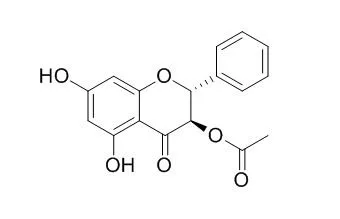| In vitro: |
| Zhongguo Zhong Yao Za Zhi. 2014 Jul;39(14):2674-8. | | A new flavonone from seeds of Alpinia katsumadai and its neuroprotective effect on PC12 cells.[Pubmed: 25272494] |
METHODS AND RESULTS:
A new flavonone, named as (2R, 3S)-pinobanksin-3-cinnamate(1), together with six known compounds, pinocem-brin (2), pinobanksin (3), 3-O-Acetylpinobanksin (4), galangin (5), kumatakenin(6), and 3-methylkaempferol (7), were isolated from a 95% ethanol extract of seeds of Alpinia katsumadai through a combination of various chromatographic techniques, including silica gel and Sephadex LH-20. The structure of compound 1 was elucidated by spectroscopic data analysis.
CONCLUSIONS:
Compound 1 exhibits a potent neuroprotective effect against the corticosterone-damaged PC12 cells, which may be underlying the effect by scavenging intracellular ROS. | | Rapid Commun Mass Spectrom. 2008 Dec;22(23):3802-8. | | Negative ion 'chip-based' nanospray tandem mass spectrometry for the analysis of flavonoids in glandular trichomes of Lychnophora ericoides Mart. (Asteraceae).[Pubmed: 18980260] | This paper reports a method for the analysis of secondary metabolites stored in glandular trichomes, employing negative ion 'chip-based' nanospray tandem mass spectrometry.
METHODS AND RESULTS:
The analyses of glandular trichomes from Lychnophora ericoides, a plant endemic to the Brazilian 'cerrado' and used in traditional medicine as an anti-inflammatory and analgesic agent, led to the identification of five flavonoids (chrysin, pinocembrin, pinostrobin, pinobanksin and 3-O-Acetylpinobanksin) by direct infusion of the extracts of glandular trichomes into the nanospray ionisation source. |
|






 Cell. 2018 Jan 11;172(1-2):249-261.e12. doi: 10.1016/j.cell.2017.12.019.IF=36.216(2019)
Cell. 2018 Jan 11;172(1-2):249-261.e12. doi: 10.1016/j.cell.2017.12.019.IF=36.216(2019) Cell Metab. 2020 Mar 3;31(3):534-548.e5. doi: 10.1016/j.cmet.2020.01.002.IF=22.415(2019)
Cell Metab. 2020 Mar 3;31(3):534-548.e5. doi: 10.1016/j.cmet.2020.01.002.IF=22.415(2019) Mol Cell. 2017 Nov 16;68(4):673-685.e6. doi: 10.1016/j.molcel.2017.10.022.IF=14.548(2019)
Mol Cell. 2017 Nov 16;68(4):673-685.e6. doi: 10.1016/j.molcel.2017.10.022.IF=14.548(2019)